Find the Best Virtual Room Design App
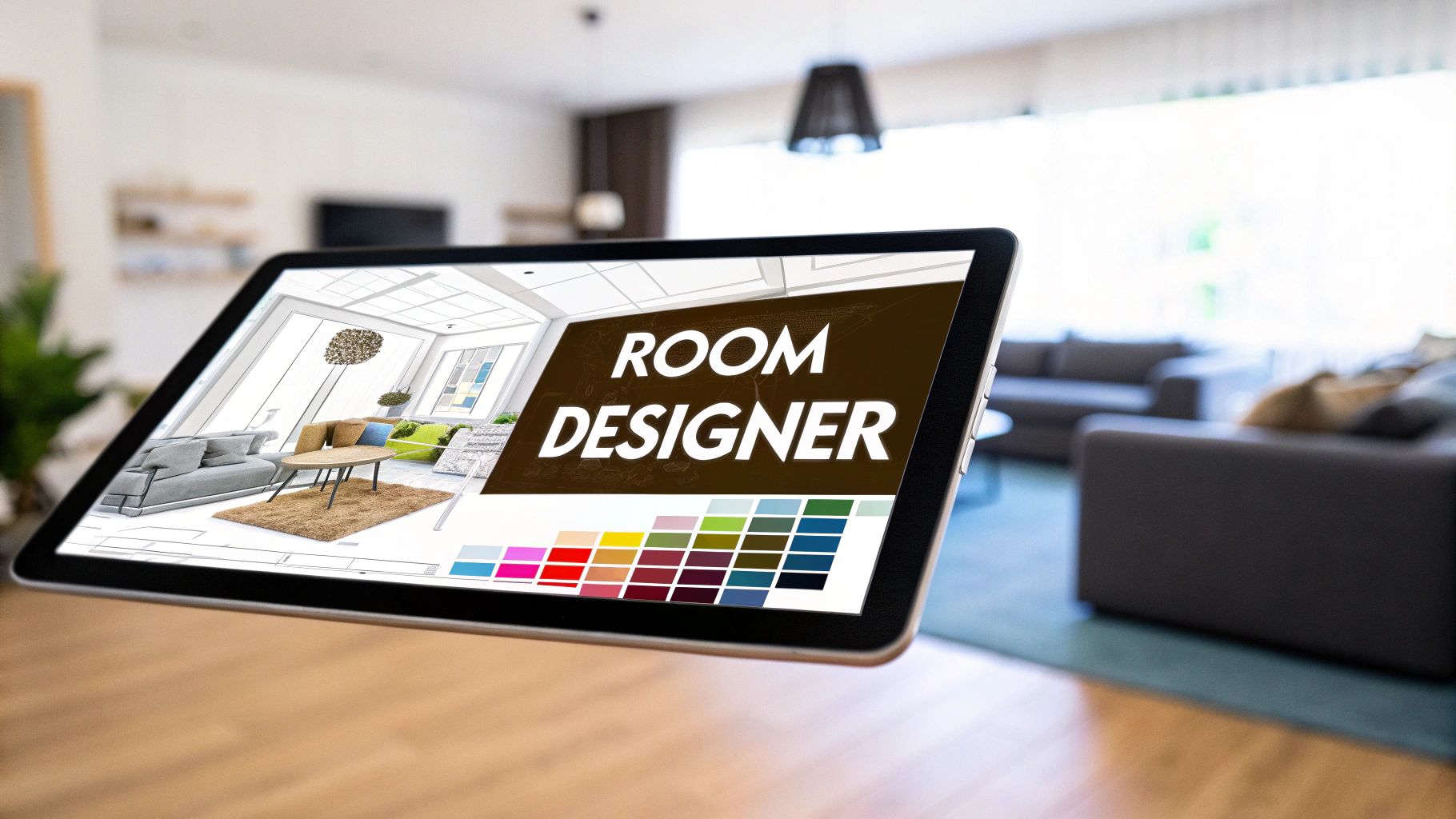
Ever found yourself staring at a blank room, completely paralyzed by all the design possibilities? Or maybe you’ve bought a piece of furniture you loved in the store, only to get it home and realize it just doesn’t work? That’s the exact problem a virtual room design app solves.
Think of it as your personal design playground—a risk-free digital sandbox where you can try out different layouts, swap furniture, and splash wild paint colors on the walls before you spend a dime or lift a paintbrush.
What Is a Virtual Room Design App, Really?
At its heart, a virtual room design app is all about taking the guesswork out of decorating. It uses a combination of 3D modeling and, in some cases, augmented reality (AR) to create a digital twin of your actual room. This lets you see exactly how that oversized sectional will fit or if that dark accent wall will make the space feel too cramped.
What was once complex, expensive software built exclusively for architects and professional designers is now incredibly accessible. Thanks to these apps, anyone—from homeowners and renters to the most ambitious DIYer—can visualize changes with surprising accuracy. This newfound power to make confident, informed decisions is a huge reason they’ve become so popular.
From 2D Blueprints to AI-Powered Concepts
The technology has come a long way. The earliest versions were pretty clunky, often limited to creating simple, flat 2D floor plans. It was helpful, but it didn’t really give you a feel for the space.
Fast forward to today, and a modern app like RoomGenius can use AI to generate entire design concepts from just a single photo of your room. It’s a fascinating look at where home styling is headed.
The market reflects this boom. The 3D home design software market, the engine behind these apps, was valued at around $1.142 billion in 2025 and shows no signs of slowing down.
Seeing Is Believing
There’s nothing quite like seeing your idea come to life. The image below gives you a peek into a typical app interface, where you can see furniture and decor being placed inside a 3D model of a room.
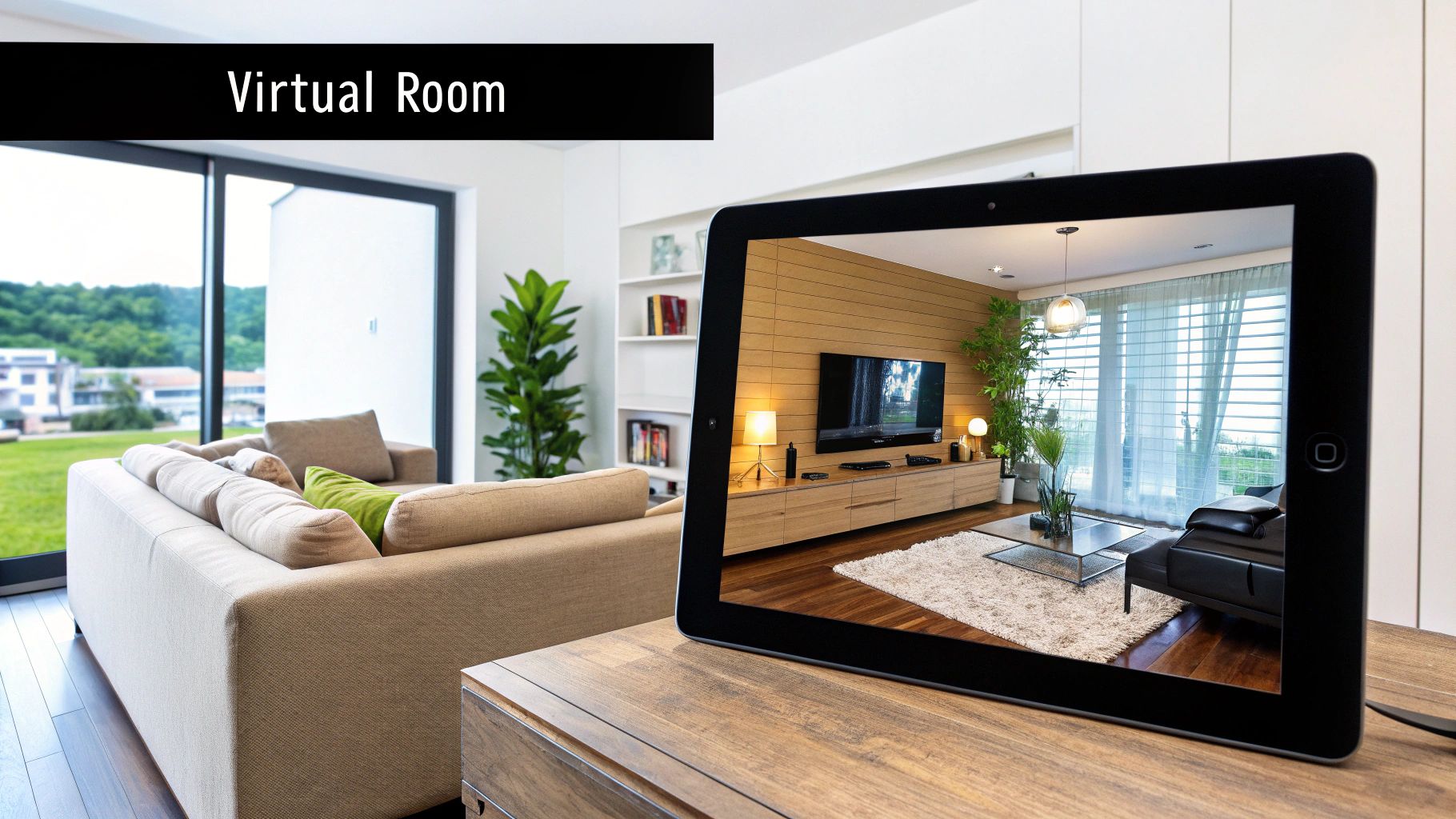
This is where the magic happens. You can drag and drop a new couch, experiment with different wall colors, and even walk around your virtual space to see how it feels from every angle. It makes abstract ideas feel real and tangible.
The real power of a virtual room design app is its ability to close the gap between your imagination and reality. It turns a fuzzy concept in your head into a detailed, interactive model, preventing expensive mistakes and giving you the confidence to create a space you’ll love.
Ultimately, these tools have opened up the world of interior design to everyone. They put powerful visualization tools right in your pocket, offering a practical way to plan, experiment, and perfect your vision before you commit to the real thing.
How These Design Apps Bring Your Vision to Life
Ever wonder how an app can take a simple photo of your room and turn it into a design playground? It’s not magic, but it feels pretty close. The process breaks down what can feel like a massive project—redesigning a room—into a few simple, manageable steps. It’s less about being a technical wizard and more about letting your own creativity run wild.
It all starts with giving the app your “canvas.” You usually have two options here: upload a photo of the room you already have, or just use your phone’s camera to snap a new one. This single picture becomes the digital foundation for everything that comes next.
Once the photo is in, you tell the app the room’s basic dimensions. Think length, width, and ceiling height. This step is absolutely crucial. It’s what ensures that the beautiful virtual sofa you fall in love with will actually, you know, fit in your real-life living room.
Stepping Into the Creative Sandbox
With the boring stuff out of the way, the fun begins. You’re essentially handed the keys to a massive digital warehouse packed with furniture, paint colors, rugs, and decor. It’s like being let loose in a home goods store with an unlimited budget and zero consequences.
You can drag a sectional sofa against one wall, then instantly swap it for two armchairs to see how that feels. Does that dark-wood coffee table work, or would a glass one open up the space? This is your chance to experiment with layouts, play with color palettes, and see how different textures work together before you spend a dime.
This whole creative workflow is a pretty simple, step-by-step journey.
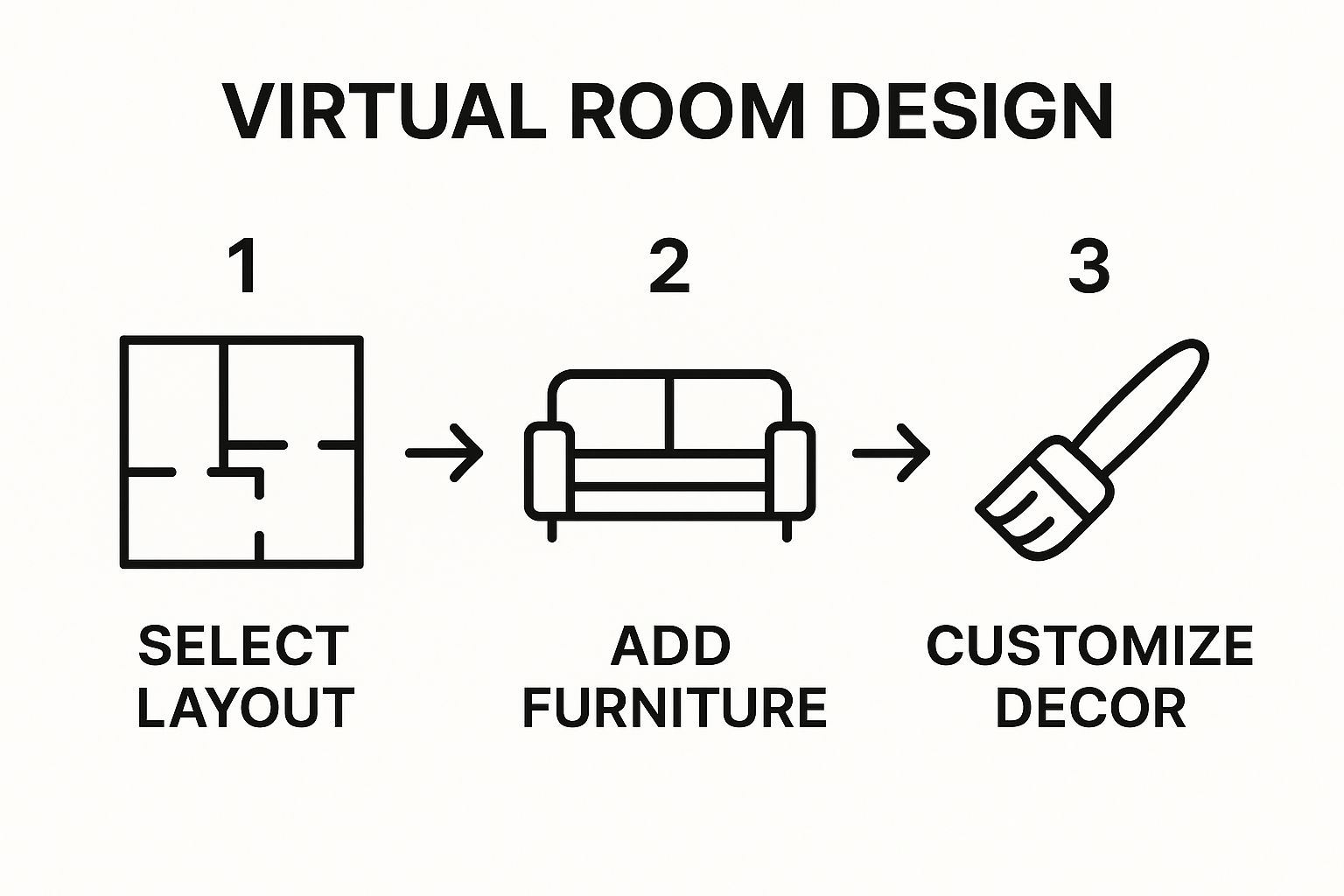
As you can see, the process naturally guides you from the big-picture decisions, like where the furniture goes, all the way down to the tiny details that really make a room feel like home.
From a Digital Mockup to a Realistic Preview
The final piece of the puzzle is seeing it all come together. The app takes all your choices and renders them into a high-quality 3D image, showing you how light from a window might fall across your new armchair. But the best apps take it even one step further.
The real “aha!” moment often comes when you switch to the augmented reality (AR) view. This feature uses your phone’s camera to overlay the digital furniture and decor directly into your actual room. You can literally walk around and see how that new floor lamp looks next to your existing bookshelf.
This powerful mix of features takes the guesswork completely out of the equation. What used to be a process of hoping for the best becomes a confident, clear plan. You go from a blank slate to a fully realized design that you know you’ll love in the real world.
Choosing an App with Features That Matter
So, you’re ready to try a virtual room design app. Great! But hold on—not all of them are built the same. While plenty of apps let you drag and drop a generic-looking sofa into a boxy room, the truly useful ones have features that make a real difference. Knowing what to look for is the key to finding a tool that helps you design, not just one that wastes your afternoon.
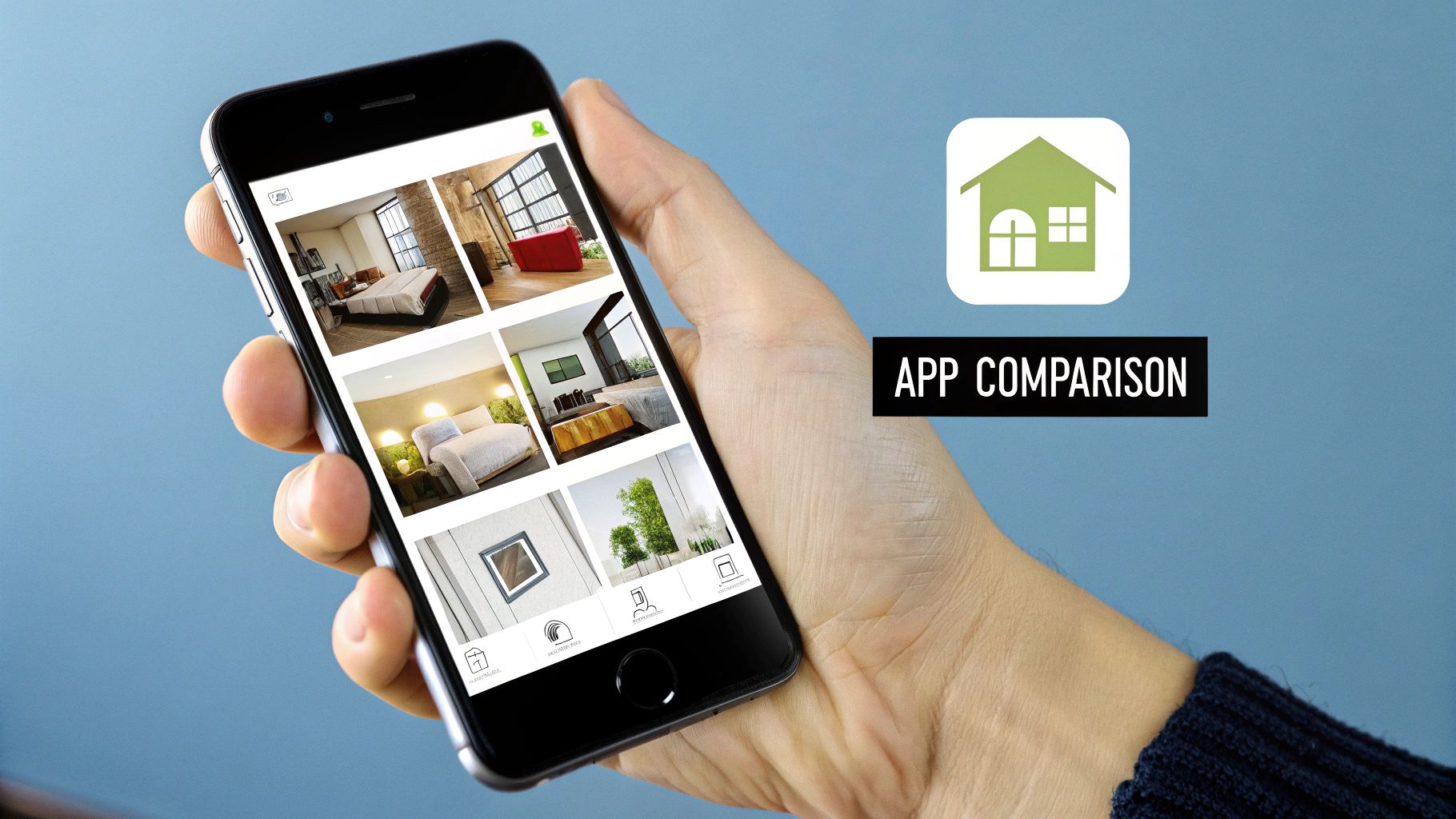
The first thing I always check? The product library. A top-tier app will have a massive catalog filled with furniture and decor from actual brands you can buy. This is huge. It turns your design from a vague idea into a concrete, shoppable plan. You’re not just placing a chair; you’re placing the chair.
Core Functionality for Accurate Planning
Beyond a good product catalog, there are a few non-negotiable features. Without these, you’re not really planning—you’re just playing a game.
Here’s what I consider the bare minimum for any serious design app:
- Accurate Measurement Tools: The app absolutely must let you plug in your room’s exact dimensions. This is the foundation for everything. If the scale is off, the whole plan is useless.
- High-Fidelity 3D Rendering: You need to see your space in realistic 3D. A flat, 2D floor plan just can’t show you how that tall bookcase will feel next to the window or how light will play off the new paint color.
- Intuitive Drag-and-Drop Interface: The tool shouldn’t require a degree in computer science to operate. A simple, clean interface means you can spend your energy on being creative, not fumbling with clunky controls.
These fundamentals are what separate a powerful planning tool from a simple digital distraction.
A truly effective virtual room design app doesn’t just show you what a room could look like; it shows you what it will look like with real products, in your real space, to real-world scale. This precision is what prevents costly purchasing mistakes.
Advanced Features That Elevate the Experience
Once you’ve got the basics covered, you can start looking for the fun stuff—the features that really take your project to the next level. The most impressive one, by far, is an Augmented Reality (AR) mode. This lets you use your phone’s camera to “place” a virtual piece of furniture right in your actual room. It’s the ultimate way to see if that sofa is too big or if that rug color clashes with your floors.
AR and its cousin, Virtual Reality (VR), are completely changing the game by making spatial and aesthetic planning incredibly precise. As more apps, both free and paid, build in these features, powerful design tools are becoming available to everyone. If you want to dive deeper into market trends, you can explore more about 3D home design software trends.
Finally, if you’re not designing in a vacuum, look for collaboration features. The ability to share a link to your design and get feedback directly in the app from a partner, family member, or client is a lifesaver. It cuts down on confusing email chains and makes sure everyone is on the same page.
Essential vs. Advanced App Features
Trying to decide which features you actually need? It really depends on your project. A casual user redecorating a bedroom has different needs than a professional designer or someone planning a major renovation. This table breaks down the must-haves versus the nice-to-haves.
| Feature | What It Does | Who Needs It (Casual User vs. Pro) |
|---|---|---|
| Product Library | Provides a catalog of real-world furniture and decor you can place in your design. | Essential for Both: Turns concepts into shoppable, realistic plans. |
| Accurate Measurement Tools | Allows you to input exact room dimensions for a true-to-scale layout. | Essential for Both: Without this, the design is just a guess. |
| 2D/3D Views | Lets you switch between a top-down floor plan and a realistic 3D model. | Essential for Both: 2D is for layout, 3D is for visualization. |
| Augmented Reality (AR) Mode | Uses your phone’s camera to overlay virtual items into your real room. | Advanced: A game-changer for serious renovators and pros. |
| Collaboration Tools | Allows you to share designs and get feedback from others within the app. | Advanced: Invaluable for pros working with clients or couples. |
| Custom Texture/Color Upload | Lets you upload your own paint colors, flooring images, or fabric swatches. | Advanced: Perfect for pros needing to match specific materials. |
Ultimately, the best app for you is one that has the core functions down pat and offers the advanced tools that match the complexity of your project. Don’t pay for features you’ll never use, but don’t skimp on the basics that ensure your plan is accurate and achievable.
Who Can Benefit from a Virtual Design App
It’s a common misconception that virtual room design apps are just for professional interior designers. That’s a bit like saying a camera is only for professional photographers. The reality is, these tools are built for just about anyone with a space to decorate, from a homeowner planning a massive renovation to a renter just trying to make sure a new sofa will fit.
The real power of this technology lies in its versatility. It’s a visual problem-solver. It doesn’t matter if your “problem” is picking the perfect paint color or mapping out a complete home extension—these apps help you avoid expensive mistakes by putting powerful planning tools right in your hands.
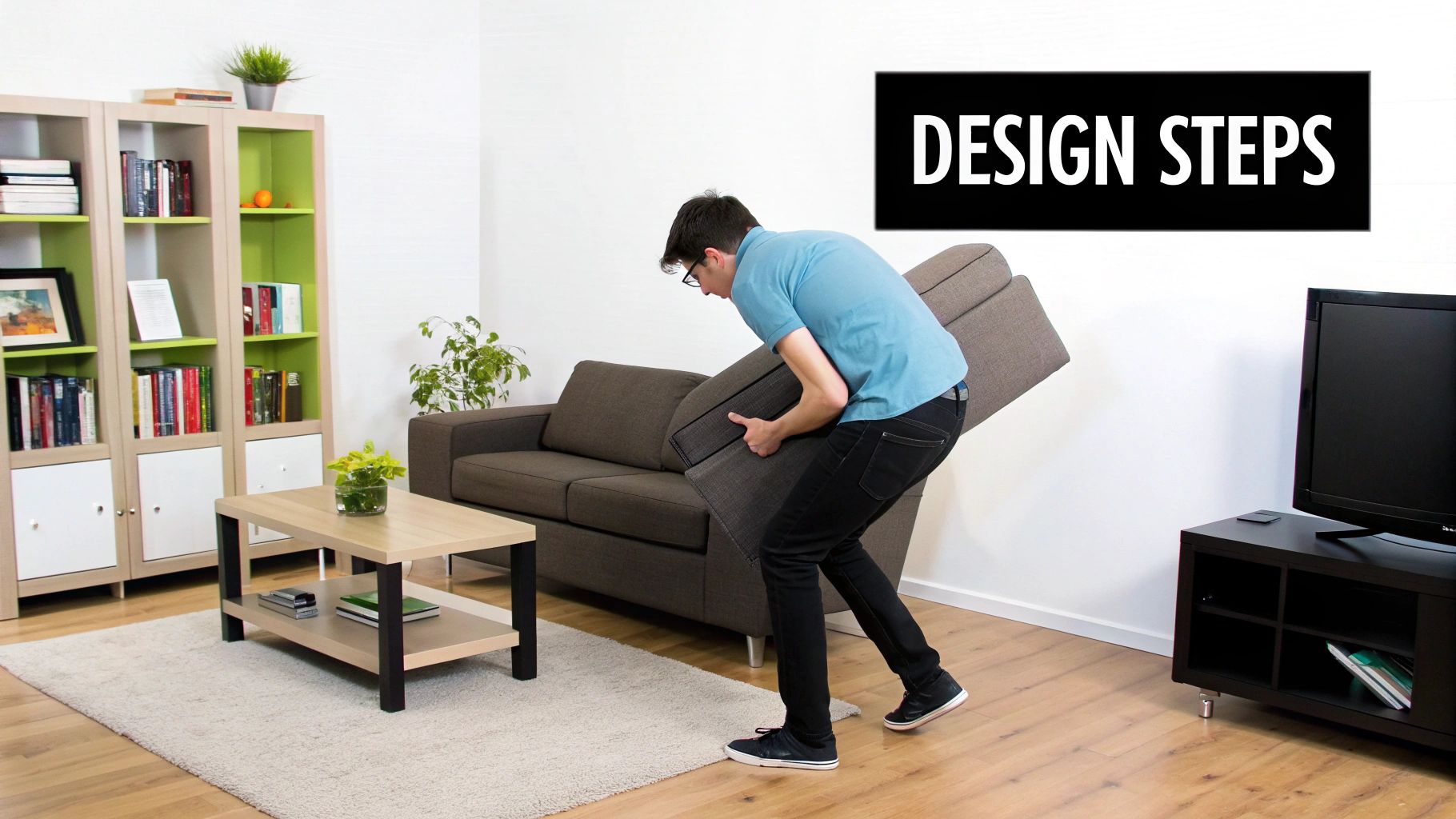
So, who stands to gain the most from bringing a design app into their project? Let’s break it down.
Homeowners Planning a Change
For any homeowner, a virtual design app is basically a risk-management tool. Think about it: planning a kitchen remodel, a basement finish, or even a small bathroom update involves decisions that are costly and frustrating to undo. This is where virtual planning is a lifesaver.
Instead of just hoping that new kitchen island won’t kill the room’s flow, you can drop a 3D model of it into your digital floor plan and “walk” around it. You can see how much light that new window will actually let in or confirm that your dream sectional sofa won’t completely overwhelm the living room. It turns expensive guesswork into a confident, well-thought-out plan.
Renters Making a Space Their Own
Renters have a totally different set of challenges. The game is all about maximizing space and adding personality without making permanent changes that could cost them their security deposit. A virtual room design app is the perfect companion for this.
Before you even sign a lease, you can use an app to see if your furniture will actually fit into the new apartment. That alone can save you from a massive moving-day headache. Once you’re in, you can experiment with non-permanent decor—rugs, standing lamps, artwork—to see how you can make the space feel like home without touching a can of paint.
For renters, these apps are about smart, temporary design. They offer a way to create a home that feels truly yours, all while respecting the landlord’s rules and ensuring you get your deposit back.
The Ambitious DIY Enthusiast
If you’re the kind of person who loves getting your hands dirty with home projects, a design app is your ultimate creative canvas. It’s a playground where you can test out your boldest ideas with zero risk or commitment.
Tempted to paint a dramatic, dark accent wall but worried it’ll make the room feel like a cave? Test it virtually first. Thinking about an unconventional furniture layout for a tricky, L-shaped room? Drag and drop different pieces until you nail the perfect arrangement. This digital sandbox lets you refine your vision, create a solid project plan, and head into your next DIY adventure with a clear, validated roadmap.
Putting Popular Design Apps to the Test
Feature lists and spec sheets are one thing, but the true measure of any virtual room design app is how it holds up on a real project. So, let’s step away from the theory and see how people are actually using these tools to solve real-world design problems—turning frustrating spaces into something functional and beautiful.
These quick examples show how different apps flex different muscles. You’ll see how choosing the right tool can be a game-changer, whether you’re wrestling with a bizarre layout, trying to pull together a cohesive look with actual products, or just need to see a new color on the walls before you start painting.
Tackling Tricky Spaces with AI
We’ve all seen them: living rooms with sloped ceilings, off-center fireplaces, and that one awkward nook that seems to defy any logical furniture arrangement. It’s a classic design headache where standard layouts just fall flat. One user, staring down this exact problem, turned to an app with powerful AI suggestion features, similar to what you’d find in RoomGenius.
Instead of just guessing and dragging furniture around, they snapped a photo and let the AI analyze the tricky layout. The app came back with several surprisingly clever solutions:
- One idea transformed the awkward nook into a cozy reading corner with a custom-fit bench.
- Another suggested a floating media console to make the fireplace wall feel lighter and less cluttered.
- A third option introduced an L-shaped sectional that defined the main seating area perfectly without killing the flow of the room.
The AI helped them see possibilities they never would have thought of on their own, turning a challenging room into a unique, highly functional space.
Designing and Shopping from a Single App
Another common challenge is creating a complete, shoppable look from scratch. Think of a renter moving into her first studio apartment. She wanted a cohesive design but was completely overwhelmed by hopping between dozens of different websites. Her solution? An app known for its extensive library of brand-name products.
She started by plugging in her studio’s dimensions. Then, she began “shopping” right inside the app. She could place a specific sofa from West Elm, pair it with a rug she liked from Crate & Barrel, and experiment with different IKEA lighting fixtures—all within her virtual room.
This is the point where a design app evolves from a simple visualization tool into a full-blown project management hub. It bridges the gap between the creative design work and the practical reality of buying everything, saving a ton of time and guesswork.
Once she finalized the entire design, she just added the items to her shopping cart using the app’s direct links. Every single piece was a real product. The end result was a perfectly coordinated apartment, designed and sourced without ever leaving the couch. This convenience is exactly why the virtual interior design market is exploding. In fact, it’s projected to hit $18.20 billion by 2025. You can read more about the rapid expansion of virtual interior design services.
As you can see, different apps are built to solve different problems. If you want to learn more about our company’s own philosophy, you can read about the RoomGenius team and our mission. Whether you need a creative boost from AI or a seamless way to shop, there’s an app out there built for your project.
Common Questions About Virtual Room Design Apps
Even with all the benefits, it’s completely normal to have a few questions before you jump in. When it comes to something as personal as your own home, you want to be sure a virtual room design app can actually deliver. Let’s tackle some of the most common things people ask.
A lot of folks worry about precision. After all, if the measurements are off, the whole plan can fall apart. It’s a totally valid concern, but one that modern tech has gotten really good at solving.
Are Virtual Room Design Apps Accurate for Measurements?
For the most part, yes. Most high-quality apps use your phone’s camera and augmented reality (AR) to create a surprisingly accurate model of your space. They’re fantastic for getting a reliable sense of scale and flow.
You can confidently see if that new sofa will completely overwhelm your living room or figure out how much clearance you’ll have around a dining table. That said, for things that need to be perfect down to the millimeter—like ordering custom-fit cabinets—you should always, always double-check with a real tape measure.
Think of the app as your go-to for 90% of the planning. You just need that manual verification for the most critical final steps.
Can I Use Real Products from Stores in These Apps?
Absolutely, and this is where these apps really shine. The best ones have huge digital catalogs packed with real products from popular stores like IKEA, Crate & Barrel, and West Elm.
This feature turns the app from a simple layout tool into an incredibly practical shopping assistant. You’re not just designing with generic gray boxes; you’re building a visual shopping list with items you can actually go out and buy. It’s a game-changer for bridging the gap between design and reality.
The ability to design with real, purchasable products closes the gap between imagination and execution. It ensures that the beautiful room you create on your screen is not just a concept, but an achievable reality.
Do I Need Any Design Experience to Use These Apps?
Not at all. These tools are built from the ground up to be intuitive for everyone, whether you’re a seasoned pro or have never thought about design before. They essentially put the power of an interior designer right in your pocket.
With simple drag-and-drop controls, pre-made templates, and even AI that suggests layouts for you, a good virtual room design app lets you experiment with total confidence. The interfaces are designed to get out of your way so you can focus on your creative vision, not on learning complicated software.
Finally, a crucial question on many people’s minds is data security. When you upload photos of your home, you need to know that your information is being handled responsibly. It’s always smart to review an app’s privacy policy. You can learn more about how to approach this by reading about our commitment to data privacy. This helps ensure you can design with complete peace of mind, focusing only on creating a space you love.
Ready to stop guessing and start visualizing? With RoomGenius, you can use AI to see your room’s potential in seconds. Upload a photo and let our technology generate stunning, practical design ideas tailored just for you.